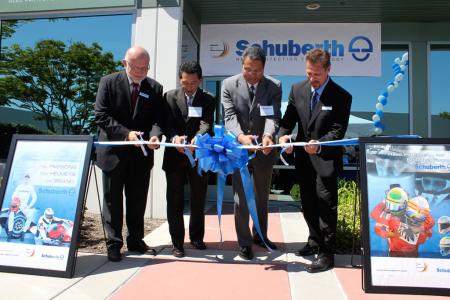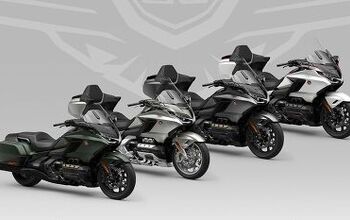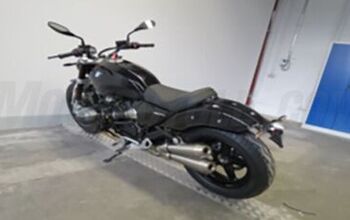Schuberth North America Opens Its Doors
With last week’s opening of Schuberth’s administrative facility in Aliso Viejo, Calif., U.S. riders now have another premier helmet to choose from, even if for now, only the men’s and women’s version of its vaunted C3 flip-up touring model is being imported.
Schuberth, which is based in Magdeburg, Germany, has long been known for its highly-engineered and pricey helmets designed for a laundry list of industries and sports, including auto racing and motorcycling.
Citing lost consumer confidence after distributor Fairchild Sports ceased Schuberth importation, then went out of business altogether, Schuberth World Wide’s CEO Marcel Lejeune, was on hand from Germany to personally usher in Schuberth’s renewed commitment.
“We have many customers here, more than 30,000 and many were unhappy because they couldn’t get the service any more they wanted.” Lejeune said, “We didn’t want to do this again, and we have decided to bypass importers and create our own company called Schuberth North America and import ourself, take our destiny in our own hands and work here directly in the market.”
Among other luminaries, Lejeune was joined by his new General Manager, Randy Northrup, as well as Aliso Viejo Mayor Phillip Tsunoda, Schuberth-sponsored Indy Car Racer Townsend Bell, and Tim Buche, who is concurrently the president and CEO of the Motorcycle Industry Council, Motorcycle Safety Foundation and the Small Vehicle Institute of America.
Buche’s attendance marked Schuberth’s having recently joined the MIC, and he offered a membership plaque and hearty welcome for the German helmet maker.
“We want consumers to make good choices, and certainly Schuberth is a good choice,” Buche told the crowd of about 40-50.
A moment before the ribbon cutting, the affable and charismatic Lejeune, who’d drawn laughter for insisting he take his sunglasses off for the photos, so he wouldn’t “look like a Mafiosi,” drew further approval and applause as he charged Northrup to do a good job. Northrup has worked previously for Scorpion and Icon helmets, and he and crew had spent seven months planning in advance of the new facility.
“For you especially, Randy, and for your team, by cutting this ribbon here, the game starts. No more discussions, no more plans, no more changes. The work starts. Know you have to deliver,” Lejeuene said with all sobriety mixed at the same time with a light hearted and well-timed dramatic tone, “So you still have a chance of asking me not to cut it. But if you don’t insist you aren’t, we’re going to do it, and after this, no more excuses. Please bring these helmets to this market!”
For the time being, Schuberth will only bring two versions of one $699 helmet to market, but the C3 and the women’s C3W version is reportedly responsible for a great deal of its sales. The company says it is the lightest of its type, most aerodynamic, and quietest.
The helmet is a showcase of Schuberth technology, including a pinlock visor, an integrated retractable interior sun visor, and claimed sound level of just 84 dB at 62 mph thanks in part to a neck-hugging wind curtain and tabs on the top of the clear face shield to reduce wind noise. The shield easily releases without tools. The helmet employs a fumble-free microlock closing system, and Anti-Roll-Off System (AROS) in the back of the helmet to keep it in place in the event of a frontal collision. At 62 mph, it’s said to flow 1.8 gallons of air per second with vents open, and is offered in two shell sizes to handle its range of XXS-XXXL.
Other Schuberth helmets sold in Europe are not being imported as of yet because they have not gone through DOT certification. They do meet the European ECE standard, but not the Snell standard.
Lejeune says while there are several motorcycle helmet certifications standards now, and more being proposed, his company does not intend to meet the Snell standard, and feels the DOT and ECE standards are more than sufficient.
He said he is unaware of controversy over Snell standards in the past several years, but regardless, vouched for his products as being engineered to be on par with makers such as Arai and Shoei, which do meet Snell standards.
Later, during a presentation inside the newly opened facility, Lejeune elaborated on the German maker’s 70-year history and ongoing dedication to providing the best possible safety for any kind of helmet on which the company puts its name.
Included were video demonstrations of military helmets deflecting 9mm small arms fire, and riot helmets meant to withstand molotov cocktails, propelled chemicals and bludgeoning by iron-bar-wielding protestors. Another video graphically demonstrated the efficacy of a shielded helmet meant to protect an electrician from a flaming 3,000-volt short circuit. A helmeted mannequin was utterly flambéed from the torso up by a flaming, sparking junction box, but at least the helmet protected its face and head. Another video showed molten steel being poured on a Schuberth hard hat meant for foundry use which was then flipped over to demonstrate an un-melted, and relatively cool interior.
The message dramatically driven home was that Schuberth thoroughly designs its helmets as solutions for all conceivable eventualities, and each of its helmets are specifically designed for given applications.
Speaking directly to motorcyclists, Lejeune said the commitment is the same: Schuberth helmets are uncompromised, and the beneficiary of research, development and testing prowess second to none.
These assertions actually only reinforce a reputation that preceded the German helmet maker, despite any supply problems the company has suffered in the past.
For years some BMW aficionados in particular were known to travel to Germany and bring back a Schuberth helmet. These coveted lids were as “made in Germany” as their motorcycles, and worn as prized possessions.
Lejeune, who’s headed Schuberth for the past three years, said his company invented the flip-up full face helmet in the 1970s, while conceding it and BMW have an ongoing friendly disagreement as to who first came up with the idea.
Proof that Schuberth yet has raving fans was evidenced by several Iron Butt rally riders who’d moto-trekked from northern California and elsewhere on their adventure-touring-oriented KTMs and Beemers and the like to be part of the opening ceremony.
According to Northrup, the C3 and C3W, and the $399 SRC (Schuberth Rider Communication) Bluetooth system developed by Cardo for the C3 (and suitable for already existing Schuberth C2 and Concept helmets) are being sold primarily through brick-and-mortar dealers.
To date, only a handful of dealers are carrying the helmets, and Schuberth North America is selectively seeking more high-quality, service-oriented dealers to sell through. The buy-in for charter dealers includes a full selection of all Schuberth products in all colors and sizes.
Schuberth’s limited range of U.S. products will be available online, too, Northrup says, and plans to roll out nationwide regional servicing dealers are still ongoing.
The company will use a third-party shipping and receiving facility, and will not warehouse the helmets at Aliso Viejo. The new facility and its staff of seven will handle marketing, administrative and warranty operations for the small but not insubstantial company.
Lejeuene said some time around June, 2011 another ECE and DOT-certified full face helmet will be brought in to complement the C3 and C3W. He did not specify whether it would be a race helmet, or street oriented, and indicated the decision will be made after Schuberth North America has had time to run for a while.
More by Jeff Cobb




































Comments
Join the conversation